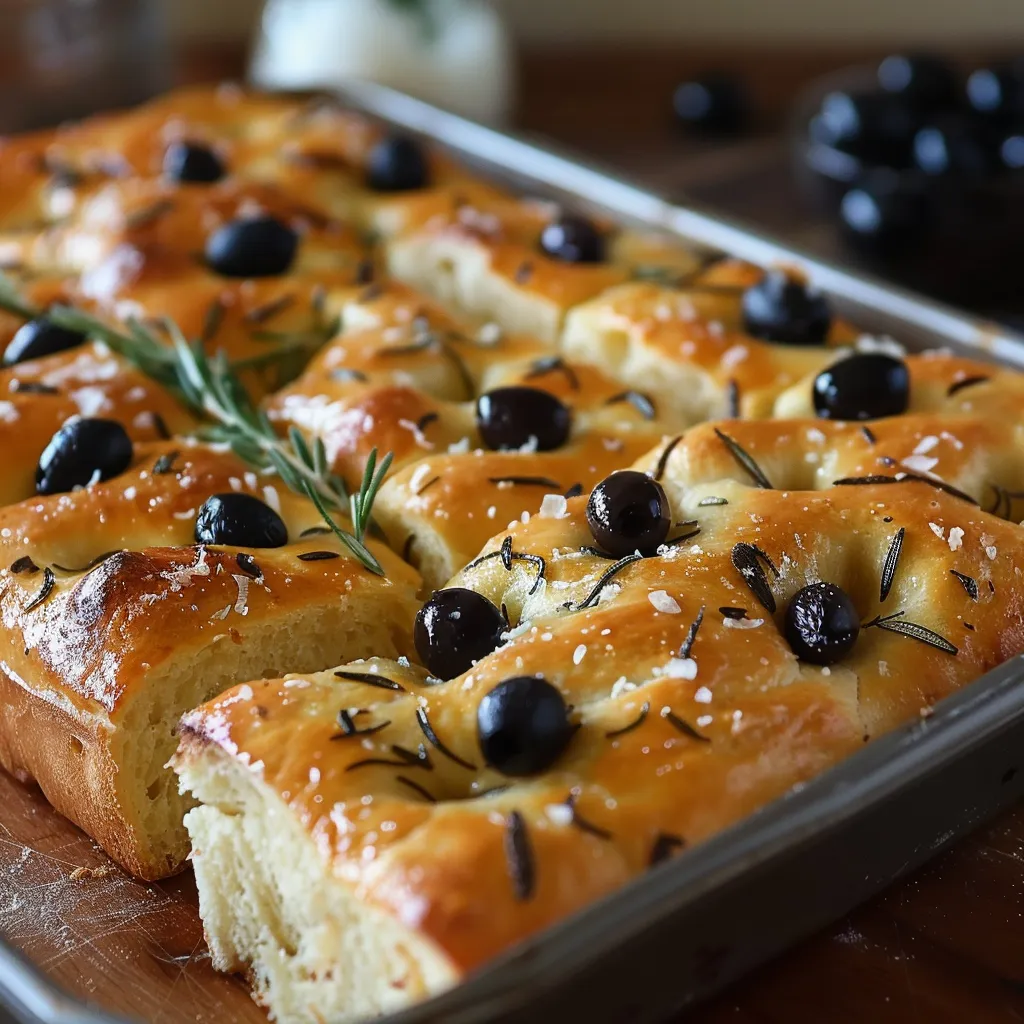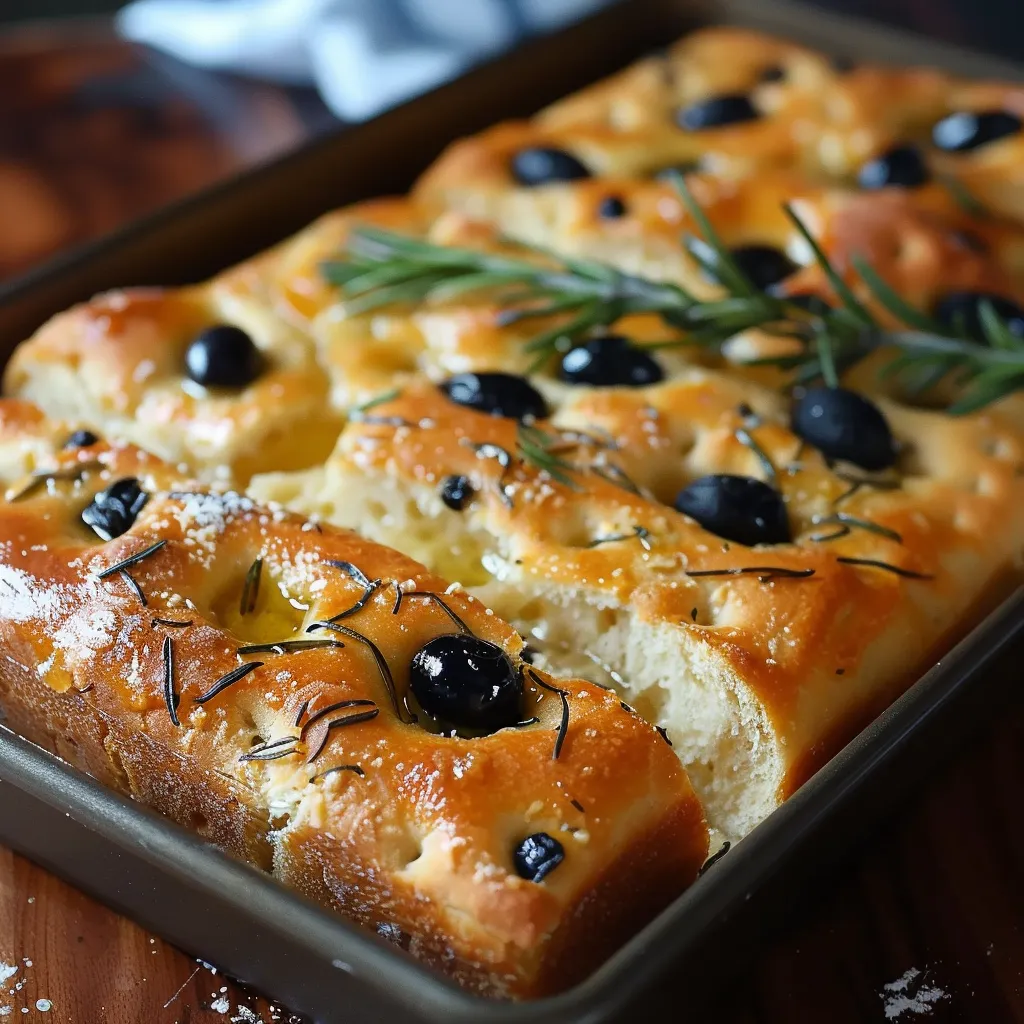 Pin it
Pin it
This innovative approach to focaccia combines traditional techniques with the practicality of a loaf tin, creating perfectly shaped bread with the characteristic dimpled surface and rich olive oil flavor. Each slice reveals a tender, open crumb structure with a golden-brown crust.
Essential Components
- Bread Flour: High protein content ensures a strong structure and perfect chew.
- Premium Extra Virgin Olive Oil: Provides an authentic, rich flavor and tender crumb.
- Active Dry Yeast: Ensures reliable fermentation for a well-risen dough.
- Pure Honey: Naturally activates the yeast while adding a subtle sweetness.
- Fine Sea Salt: Enhances the dough’s development and overall flavor balance.
- Coarse Sea Salt: Sprinkled on top for a satisfying crunch and final burst of flavor.
- Fresh Rosemary Sprigs: Infuses the bread with a fragrant, earthy aroma.
- Filtered Water: Maintains the proper hydration and consistency for the dough.
- Quality Olives: A classic topping that adds depth and a traditional Mediterranean touch.
Culinary Choreography
- Yeast Activation:
- Combine water heated to exactly 100°F with honey and yeast. Watch for proper foaming and activity. This indicates viable yeast and proper temperature.
- Initial Mixing:
- Combine flour and salt, then add activated yeast mixture. Mix until shaggy dough forms. Perform series of stretch and folds to develop strength.
- Dough Development:
- Allow for slow fermentation in refrigerator, building flavor complexity. Dough should nearly double with visible bubbles throughout.
- Pan Preparation:
- Coat loaf tins generously with olive oil. This creates characteristic crust and prevents sticking.
 Pin it
Pin it
My Italian mentor taught me to add a tiny drizzle of garlic-infused oil before baking—it adds incredible depth to the final bread.
Shaping Process
Divide dough with gentle movements to preserve air bubbles. Transfer carefully to prepared tins, allowing dough to naturally spread. Create signature dimples with fingertips, pressing deeply but not through to bottom. Drizzle generously with olive oil, ensuring it pools in dimples.
Proofing Excellence
Allow dough to rise in warm area until noticeably puffy, about 2 hours. Watch for proper volume increase and slight jiggle when pan is gently shaken. Dough should be soft and pillowy when touched.
Topping Application
Arrange fresh rosemary sprigs thoughtfully throughout surface. Distribute olives evenly in dimples. Sprinkle coarse sea salt generously, allowing it to rest in oil-filled pockets.
Baking Method
Place in preheated 390°F oven, positioning rack in center. Steam creation optional but beneficial for crust development. Bake until deeply golden brown, about 30 minutes. Surface should show varied coloration from olive oil pooling.
Cooling Solutions
Allow bread to cool in tins for 10 minutes. Remove carefully and place on wire rack. Cool additional 20 minutes before slicing to prevent compression. Serve warm or at room temperature.
Creative Variations
Transform this basic recipe while maintaining its focaccia character. Create sundried tomato version with basil and mozzarella. Develop caramelized onion topping with thyme. Some bakers add thinly sliced potatoes and rosemary, while others incorporate pesto before baking. Consider seasonal variations with different herbs and vegetables.
 Pin it
Pin it
This loaf tin focaccia represents the perfect marriage of traditional Italian bread and modern convenience. The combination of proper fermentation, generous olive oil, and careful baking creates bread that's both authentic and practical. Whether served alongside pasta, used for sandwiches, or enjoyed on its own, this recipe consistently delivers the true taste of Italy with reliable results.
Frequently Asked Questions
- → Why does the dough need to proof in the fridge?
- Cold proofing develops better flavor and makes the wet dough easier to handle. The longer it proofs (up to 72 hours), the more flavorful it becomes.
- → Can I use all-purpose flour instead of bread flour?
- While possible, bread flour is recommended as its higher protein content helps manage the high hydration and creates better structure.
- → Why is the dough so wet?
- This is a 95% hydration dough, which creates the classic open, airy texture of focaccia. The wet dough is normal and necessary.
- → Can I halve the recipe?
- Yes, you can halve all ingredients to make just one loaf, but keep the yeast at 4g for reliable rising.
- → What other toppings can I use?
- Try cherry tomatoes, caramelized onions, herbs like thyme or sage, or different varieties of olives.
